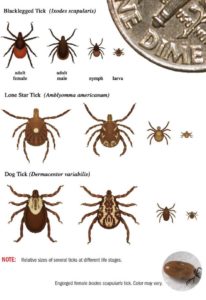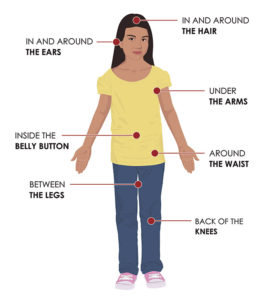Prevention is much more than half the battle
We understand that many people find ticks are…well…gross! But, it is essential to be well informed about them. All the news about Lyme and other tick-borne diseases can make living in the beautiful Hudson Valley seem a little scary. And there is good reason to be careful to make sure that you and your family can enjoy the outdoors while protecting yourself against the dangerous diseases that these tiny little creatures can carry. This article is intended to offer education and information about how to stay healthy and experience outdoor recreation in our beautiful countryside.
What are ticks?
Although most people think of ticks as insects, they are actually small wingless parasites in the arachnid family – the same family as spiders, mites and scorpions. Ticks are external parasites that live by feeding off the blood of mammals (including people), birds and sometimes reptiles and amphibians. The most common ticks in our region are blacklegged (deer) ticks, American dog (wood) ticks and lone star ticks. Being preyed on by a creature that sucks your blood isn’t a nice thought or sensation, but what is worse is that they carry a variety of very unpleasant, and even deadly diseases.
Source: Center for Disease Control
What diseases do ticks carry?
Ticks transmit diseases into the people or animals they bite including diseases like ehrlichiosis, anaplasmosis and Lyme disease. The Lone Star Tick is also known to cause alpha-gal syndrome where one develops an allergy to a sugar found in red meat and in some medications. The recently identified rare but very serious, Powassan virus causes encephalitis, an infection of the brain.
Know where to expect ticks before you go outdoors
Ticks live in grassy, brushy, or wooded areas, or even on animals. Spending time outside walking your dog, camping, gardening, or hunting could bring you in close contact with ticks. Many people get ticks in their own yard or neighborhood. In short, ticks can be found just about anywhere outside and can come in with family pets.
How do I know a tick is biting me?
Ticks are sneaky. If you have a tick on you, you may feel it crawling around. In which case, strip off and have a good look or ask a family member to look for you. Unfortunately, most often when you are actually being bitten by a tick, you don’t feel anything at all. The tick injects an anesthetic into the skin at its point of entry, which helps it avoid detection so it can continue feeding. Often children or adults with the tick-borne Lyme disease don’t recall having a bug bite of any kind.
What should I do if I find a tick attached to me?
The first thing is not to panic. Proceed slowly and carefully and follow these instructions from the Center for Disease Control:
The key is to remove the tick as soon as possible. There are several tick removal devices on the market, but a plain set of fine-tipped tweezers work very well.
How to remove a tick
Source: Center for Disease Control
-
- Use fine-tipped tweezers to grasp the tick as close to the skin’s surface as possible.
- Pull upward with steady, even pressure. Don’t twist or jerk the tick; this can cause the mouth-parts to break off and remain in the skin. If this happens, remove the mouth-parts with tweezers. If you are unable to remove the mouth easily with clean tweezers, leave it alone and let the skin heal.
- After removing the tick, thoroughly clean the bite area and your hands with rubbing alcohol or soap and water.
- Never crush a tick with your fingers. Dispose of a live tick by putting it in alcohol, placing it in a sealed bag/container, wrapping it tightly in tape, or flushing it down the toilet.
Don’t use folklore tricks to remove ticks
Avoid folklore remedies such as “painting” the tick with nail polish or petroleum jelly, or using heat to make the tick detach from the skin. Your goal is to remove the tick as quickly as possible–not wait for it to detach!
Consider calling your healthcare provider
In general, the Center for Disease Control does not recommend taking antibiotics after tick bites to prevent tick-borne diseases. At Premier Medical Group, all of our primary care providers have broad experience with tick bites, and tick-borne diseases. If you often encounter ticks where you live, talk to your primary care physician about what to do before and after a tick bite.
Watch for symptoms for 30 days
Depending on the type of tick and germ, a tick needs to be attached to you for different amounts of time (minutes to days) to infect you with that germ. Your risk for Lyme disease is very low if a tick has been attached for fewer than 36 hours. Check for ticks daily and remove them as soon as possible.
Call your healthcare provider if you get any of the following:
- Rash
- Fever
- Fatigue
- Headache
- Muscle pain
- Joint swelling and pain
Treatment for tick-borne diseases should be based on symptoms, history of exposure to ticks, and in some cases, the results of blood tests.
Where to look for ticks on your body
Ticks don’t just hide in nature. They hide on us. Make tick inspection a family habit. Check for ticks every day, on every body.
Source: Center for Disease Control
If a tick is crawling on you
Ticks must bite you to spread their germs. Once they attach to you, they will feed on your blood and can spread germs. A tick that is crawling on you but not attached or full of blood could not have spread germs. However, if you have found a tick crawling on you, it’s a sign there may be others.
Should I get my tick tested for germs?
Some companies offer to test ticks for specific germs. The CDC strongly discourages using results from these tests when deciding whether to use antibiotics after a tick bite for the following reasons:
- Results may not be reliable. Laboratories that test ticks are not required to meet the same quality standards as laboratories used by clinics or hospitals for patient care.
- Positive results can be misleading. Even if a tick contains a germ, it does not mean that you have been infected by that germ.
- Negative results can also be misleading. You might have been bitten unknowingly by a different infected tick.
Avoiding tick bites for you and your family
- Use a chemical repellent with DEET, permethrin or picaridin.
- Wear light-colored protective clothing.
- Tuck pant legs into socks.
- Avoid tick-infested areas.
- Check yourself, your children, and your pets daily for ticks and carefully remove any ticks.
When in doubt, see your doctor
If you have signs of a tick-borne disease, don’t wait to see if it goes away. Many of these illnesses can be serious, and even fatal, if not caught early. Speak to your primary care provider or ask about proactive steps when it comes to tick bites. We want you to be safe, not sorry.




